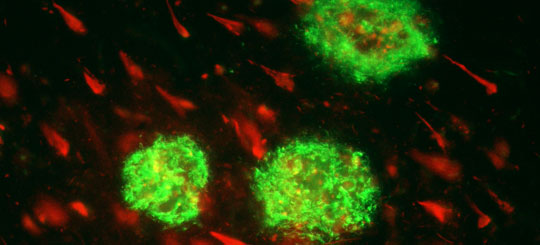UAB Neuroscientists Stretch the Boundaries of the Mind
By Bob Shepard

Image courtesy of J. Palop
The brain, as we saw in last week's story, is "plastic" in the sense that it can reshape itself after injury. But the power of plasticity doesn't stop there, says David Sweatt, Ph.D., chair of the UAB Department of Neurobiology, director of the Evelyn F. McKnight Brain Institute, and Evelyn F. McKnight Endowed Chair for Learning and Memory in Aging. According to Sweatt, the brain is also able to strengthen the connections between neurons—and even make new neurons.
Neurons, Sweatt explains, are the fundamental information-processing units of the brain. But they do not work in isolation; instead, each neuron communicates with thousands of its neighbors through specialized connections called synapses. “It turns out that perhaps half of the synapses in the adult nervous system have a robust capacity to change the strength of the connections between neurons,” Sweatt says. “That is an important part of how the brain works, how we store information, and how we adapt to environmental stimuli.”
It is also an important part of memory, says Sweatt—in fact, he argues, synapses are the keys to memory. And once scientists understand how the adult brain strengthens certain synapses, they can begin to manipulate the process—finding ways to slow down or delay the inevitable memory loss associated with aging.
“We’re trying to understand how the strength of neural connections changes at the cellular and molecular level,” says Sweatt. “Perhaps we can develop new drugs to boost plasticity processes at the synapses, which could alleviate age-related memory loss and certain types of cognitive dysfunction that are associated with neurologic and psychiatric disorders.”
UAB neurologist Erik Roberson, M.D., Ph.D., is hard at work trying to understand the molecular changes that occur at the synapses during the aging process—particularly the abnormal changes brought about by Alzheimer’s disease.
For years, Alzheimer’s was thought to be caused by large clumps of toxic proteins, called amyloid-beta (A-beta) and tau, that form in the brains of Alzheimer’s patients and are big enough to be visible through a microscope. But Roberson says it is becoming clear that these large aggregates may not deserve the heavyweight role they have been assigned.
"The clumps may actually be beneficial,” he says. “The brain may be trying to stash these toxins in a sort of garbage dump.” The true culprits now seem to be the smaller aggregates of A-beta and tau proteins that are found floating at large in the brain, gumming up its works, so to speak, by interfering with synaptic connections. “They are impairing cognition,” Roberson explains, “by thwarting the ability of neurons to modulate the strength of their connections between each other.”
In fact, Roberson speculates that the cognitive impairment experienced by Alzheimer’s patients may not be due entirely to the loss of neurons, as was once thought, but rather in part to a malfunction of the neurons that are still alive.
“We’re looking for the molecular basis of that malfunction,” he says. “If we find it, perhaps then we can tweak that system—turn something back up or back down and get those neurons functioning again without having to create a whole new brain.”
Birth of a Brain Cell
Creating whole new brains is the stuff of science fiction. Creating new brain cells, however—something called neurogenesis—is turning out to be science fact. The ability of the adult brain to grow new neurons, once scoffed at, is now accepted as a reality, says Sweatt—at least on a small scale.
“In some limited circumstances, in some limited parts of the brain, there is actually growth of brand-new neurons from stem cells resident in the nervous system,” says Sweatt. “That is certainly very contrary to even recent dogma in the neurosciences. But it’s now clear you can produce new neurons as an adult.”
The first evidence for adult neurogenesis came in the mid-1960s, with the advent of techniques that allowed researchers to begin seeing neurons forming in a few brain regions, says UAB neurobiologist Linda Overstreet Wadiche, Ph.D. “We now know that in the olfactory system and in the hippocampus—a region important for learning and memory—neurogenesis is persistent throughout life,” she says. “It slows down with age, but it is a continual process.” What’s more, Wadiche says neurogenesis is influenced by exercise, intellectual enrichment, and different disease states. Just how much of an influence each of these factors exerts—and under what conditions—is the subject of ongoing research in her lab, but “it’s clear that even quite old mice who are put in an enriched environment or who exercise can enhance the number of newborn cells in their brains.”
For Wadiche, neurogenesis is an exciting and complex mystery. But she says it is easy to see why there was opposition to the concept from many scientists. “It is difficult to think in terms of adding new neurons to an established system,” she says. “The mechanisms that control your personality, your long-term memory, need to have some stability. What happens when you add new neurons to the mix? That suggests that there is something extremely interesting going on in the brain regions where neurogenesis happens. What are these regions doing, and why does neurogenesis persist there? I think the answers will tell us a lot about how the brain works.”
Neuroplasticity research, for all the torrent of interest it has generated among scientists and the public alike, is still in its infancy. But Taub, Sweatt, Roberson, and Wadiche all agree that this is the most exciting area in neuroscience. “Understanding plasticity is central to understanding just how our brains work,” says Sweatt. “It is essential for figuring out how it is that humans can do the really cool things we can do—thinking and learning and remembering and cogitating about the future. Studying neuroplasticity will give us insights into all of that.”